Quick Summary:
- Define your niche and target audience clearly.
- Design user-friendly UI/UX with essential features.
- Choose robust tech, test thoroughly, and market well.
- Plan monetization and continuously improve your platform.
Table of Contents
- Understanding the Landscape: What is an eSports Platform Website?
- Why are eSports Platforms so Important?
- Key Components of a Successful eSports Platform Website
- Planning Your eSports Platform: Defining Your Niche and Audience
- Identifying Your Target Audience
- Choosing Your eSports Niche
- Conducting Market Research
- Designing the User Experience (UX) and User Interface (UI): Making it User-Friendly
- UX Design Principles
- UI Design Elements
- Key UI Elements for an eSports Platform
- Gamification for Engagement
- Choosing the Right Technology Stack: Selecting the Building Blocks
- Front-End Technologies
- Back-End Technologies
- Databases
- Cloud Hosting
- APIs and Integrations
- Security Considerations
- Developing Key Features: Building the Functionality
- User Registration and Profiles
- Team Management
- Tournament Creation and Management
- Matchmaking System
- Streaming Integration
- News and Content
- Payment System
- Testing and Quality Assurance: Ensuring a Bug-Free Experience
- Types of Testing
- Testing Tools
- Bug Tracking System
- Quality Assurance Best Practices
- Marketing and Promotion: Getting the Word Out
- Search Engine Optimization (SEO)
- Social Media Marketing
- Influencer Marketing
- Paid Advertising
- Community Engagement
- Monetization Strategies: Generating Revenue
- Subscription Model
- Tournament Entry Fees
- Advertising
- Sponsorships
- Merchandise
- Legal Considerations: Staying Compliant
- Terms of Service (ToS) and Privacy Policy
- Intellectual Property
- Data Privacy Laws
- Gambling Laws
- Qrolic Technologies and Your eSports Platform
- Continuous Improvement: Adapting and Evolving
- Collect User Feedback
- Monitor Industry Trends
- Implement New Features and Improvements
- Scalability and Performance
Understanding the Landscape: What is an eSports Platform Website?
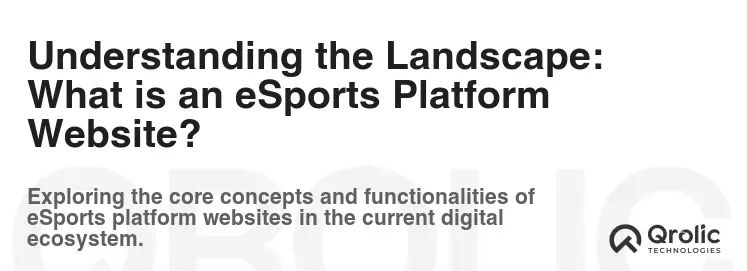
An eSports platform website acts as the central hub for everything related to competitive video gaming. It’s more than just a website; it’s a thriving community, a battleground for skilled players, and a source of entertainment for millions of fans worldwide. These platforms connect players, organizers, sponsors, and viewers, fostering a dynamic ecosystem around eSports.
Why are eSports Platforms so Important?
- Community Building: eSports platforms provide a dedicated space for players and fans to connect, discuss games, share strategies, and form teams. This sense of community is vital for the growth and sustainability of the eSports scene.
- Tournament Organization: They streamline the process of creating, managing, and participating in tournaments, from registration and scheduling to bracket generation and results tracking.
- Skill Development: Platforms offer resources for players to improve their skills, such as coaching, training programs, and access to high-level competition.
- Visibility and Exposure: eSports platforms give players, teams, and organizations increased visibility, attracting potential sponsors and expanding their fanbase.
- Monetization Opportunities: They provide various avenues for monetization, including sponsorships, advertisements, subscriptions, and prize pools.
Key Components of a Successful eSports Platform Website
- User Profiles: Allow players to create profiles showcasing their skills, achievements, and favorite games.
- Team Management: Facilitate the formation and management of teams, including roster management and communication tools.
- Tournament Creation and Management: Provide tools for organizers to create and manage tournaments, including scheduling, bracket generation, and results tracking.
- Matchmaking System: Implement a robust matchmaking system to ensure fair and balanced competition.
- Streaming Integration: Integrate with popular streaming platforms like Twitch and YouTube to allow players and organizers to broadcast matches.
- News and Content: Provide news, articles, and videos related to the eSports scene, keeping users informed and engaged.
- Community Forums: Foster a sense of community by providing forums for discussion and interaction.
- Secure Payment System: Implement a secure payment system for tournament entry fees, prize pools, and subscriptions.
Planning Your eSports Platform: Defining Your Niche and Audience

Before diving into development, you need a clear plan. This involves defining your target audience and choosing a specific niche within the vast eSports landscape. A clear understanding of these aspects will guide your design, features, and marketing efforts.
Identifying Your Target Audience
- Demographics: Consider the age, gender, location, and interests of your target audience. Are you focusing on young adults in North America or a broader global audience?
- Gaming Preferences: What games are they passionate about? Are they primarily interested in FPS games, MOBAs, or strategy games?
- Skill Levels: Are you targeting casual players, aspiring professionals, or seasoned veterans?
- Platform Preferences: Do they primarily play on PC, console, or mobile devices?
- Community Involvement: How actively are they involved in the eSports community? Do they participate in tournaments, follow professional players, or engage in online forums?
Choosing Your eSports Niche
The eSports landscape is diverse. Focusing on a specific niche allows you to cater to a specific audience and build a loyal following. Here are some niche ideas:
- Game-Specific Platform: Focus on a single popular game, such as League of Legends, Dota 2, Counter-Strike: Global Offensive, Valorant, or Overwatch.
- Genre-Specific Platform: Focus on a specific genre of games, such as FPS, MOBA, RTS, or fighting games.
- Region-Specific Platform: Focus on a specific region, such as North America, Europe, Asia, or Latin America.
- Skill-Level-Specific Platform: Focus on a specific skill level, such as amateur, semi-professional, or professional.
- Mobile eSports Platform: Focus specifically on mobile eSports, a rapidly growing segment of the industry.
- Console eSports Platform: Focus on console-based eSports tournaments and leagues.
- Educational eSports Platform: Focus on providing coaching, training, and educational resources for aspiring eSports players.
Conducting Market Research
Before committing to a specific niche, conduct thorough market research to assess the demand and competition.
- Analyze existing eSports platforms: Identify successful platforms in your chosen niche and analyze their strengths and weaknesses.
- Survey your target audience: Gather feedback on their needs and preferences through surveys and interviews.
- Research popular games and tournaments: Identify the most popular games and tournaments in your chosen niche.
- Analyze market trends: Stay up-to-date on the latest trends in the eSports industry.
Designing the User Experience (UX) and User Interface (UI): Making it User-Friendly

The user experience (UX) and user interface (UI) are crucial for the success of your eSports platform. A well-designed platform will be intuitive, engaging, and enjoyable to use, attracting and retaining users.
UX Design Principles
- User-Centricity: Design the platform with the user in mind. Understand their needs and goals and design features that meet those needs.
- Simplicity: Keep the design simple and intuitive. Avoid clutter and unnecessary complexity.
- Consistency: Maintain consistency in design elements, such as colors, fonts, and icons, throughout the platform.
- Accessibility: Ensure the platform is accessible to users with disabilities.
- Responsiveness: Design the platform to be responsive and adapt to different screen sizes and devices.
- Performance: Optimize the platform for performance to ensure fast loading times and smooth performance.
UI Design Elements
- Visual Hierarchy: Use visual cues, such as size, color, and contrast, to guide the user’s attention to the most important elements.
- Typography: Choose fonts that are easy to read and visually appealing.
- Color Palette: Choose a color palette that is consistent with your brand and appeals to your target audience.
- Imagery: Use high-quality images and videos to enhance the visual appeal of the platform.
- Icons: Use clear and consistent icons to represent different features and functions.
- Whitespace: Use whitespace to create a clean and uncluttered layout.
Key UI Elements for an eSports Platform
- User Dashboard: A personalized dashboard that displays relevant information, such as upcoming matches, tournament invitations, and notifications.
- Tournament Pages: Clear and informative tournament pages that display details such as tournament rules, prize pools, schedules, and participants.
- Match Pages: Real-time match pages that display live scores, statistics, and streaming links.
- Team Pages: Pages dedicated to teams, displaying roster information, team statistics, and upcoming matches.
- Leaderboards: Leaderboards that track player and team rankings.
- Search Functionality: A robust search function that allows users to easily find players, teams, and tournaments.
- Mobile Responsiveness: Design that adapts seamlessly to different screen sizes.
Gamification for Engagement
Incorporate gamification elements to enhance user engagement and motivation.
- Achievements and Badges: Award achievements and badges for completing certain tasks or reaching milestones.
- Leaderboards: Create leaderboards to foster competition and track player rankings.
- Experience Points (XP): Award XP for completing tasks and allow users to level up their profiles.
- Virtual Currency: Implement a virtual currency system that allows users to earn and spend currency on in-platform items or features.
Choosing the Right Technology Stack: Selecting the Building Blocks
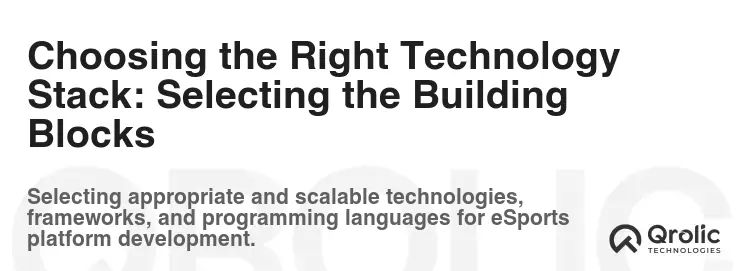
Selecting the right technology stack is crucial for building a scalable, reliable, and feature-rich eSports platform. Consider factors such as performance, security, scalability, and ease of development.
Front-End Technologies
The front-end is the user-facing part of the platform. It’s what users interact with directly.
- React: A popular JavaScript library for building user interfaces. Known for its component-based architecture, performance, and flexibility.
- Angular: A comprehensive JavaScript framework for building complex web applications. Offers strong structure, maintainability, and scalability.
- Vue.js: A progressive JavaScript framework that is easy to learn and use. Offers a good balance of flexibility and performance.
- HTML, CSS, JavaScript: The fundamental building blocks of the web. Essential for creating the structure, style, and interactivity of the platform.
Back-End Technologies
The back-end is the server-side part of the platform. It handles data storage, processing, and security.
- Node.js: A JavaScript runtime environment that allows you to run JavaScript on the server-side. Known for its scalability and performance.
- Python (Django/Flask): Python is a versatile language that can be used for building web applications. Django and Flask are popular Python web frameworks.
- PHP (Laravel/Symfony): PHP is a widely used server-side scripting language. Laravel and Symfony are popular PHP web frameworks.
- Java (Spring): Java is a robust and scalable language that is well-suited for building enterprise-level applications. Spring is a popular Java framework.
Databases
Databases are used to store and manage the platform’s data.
- MySQL: A popular open-source relational database management system.
- PostgreSQL: Another popular open-source relational database management system. Known for its reliability and features.
- MongoDB: A NoSQL database that is well-suited for storing unstructured data.
Cloud Hosting
Cloud hosting provides the infrastructure and resources needed to run the platform.
- Amazon Web Services (AWS): A comprehensive cloud computing platform that offers a wide range of services.
- Google Cloud Platform (GCP): Another comprehensive cloud computing platform that offers a wide range of services.
- Microsoft Azure: A cloud computing platform that offers a wide range of services.
APIs and Integrations
- Streaming APIs (Twitch, YouTube Gaming): Integrate with streaming platforms to allow users to broadcast and view matches.
- Payment Gateways (Stripe, PayPal): Integrate with payment gateways to process payments for tournament entry fees, prize pools, and subscriptions.
- Social Media APIs (Facebook, Twitter): Integrate with social media platforms to allow users to share content and connect with friends.
- Game APIs: Integrate with game APIs to retrieve game data, such as player statistics and match results.
Security Considerations
Security is paramount when building an eSports platform.
- Data Encryption: Encrypt sensitive data, such as passwords and financial information.
- Authentication and Authorization: Implement robust authentication and authorization mechanisms to protect user accounts and data.
- Vulnerability Scanning: Regularly scan the platform for vulnerabilities and patch them promptly.
- Protection Against DDoS Attacks: Implement measures to protect the platform against Distributed Denial of Service (DDoS) attacks.
Developing Key Features: Building the Functionality
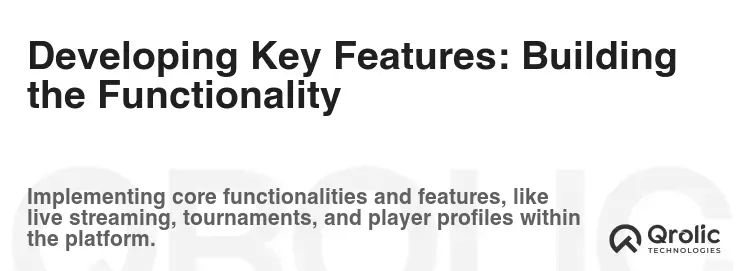
Now, it’s time to translate your plan and design into a functional eSports platform. Focus on building the core features that will attract and retain users.
User Registration and Profiles
- Secure Registration Process: Implement a secure registration process with email verification and strong password requirements.
- Detailed User Profiles: Allow users to create detailed profiles with information such as their username, avatar, biography, favorite games, skill level, and social media links.
- Privacy Settings: Allow users to control the visibility of their profile information.
Team Management
- Team Creation and Management: Allow users to create and manage teams, including inviting members, assigning roles, and managing team settings.
- Team Rosters: Allow teams to manage their rosters, including adding and removing players.
- Team Communication Tools: Provide team communication tools, such as chat and forums.
Tournament Creation and Management
- Tournament Creation Wizard: Provide a user-friendly wizard that guides organizers through the process of creating a tournament.
- Tournament Settings: Allow organizers to configure various tournament settings, such as game, format, prize pool, schedule, and rules.
- Bracket Generation: Automatically generate tournament brackets based on the chosen format.
- Match Scheduling: Allow organizers to schedule matches and send notifications to participants.
- Results Tracking: Allow organizers to track match results and update the tournament standings.
Matchmaking System
- Skill-Based Matchmaking: Implement a matchmaking system that matches players based on their skill level.
- Queue System: Implement a queue system that allows players to join a queue and wait for a match.
- Match Notifications: Send notifications to players when a match is found.
- Fair Play Enforcement: Implement measures to prevent cheating and ensure fair play.
Streaming Integration
- Twitch Integration: Integrate with Twitch to allow players to stream their matches directly from the platform.
- YouTube Gaming Integration: Integrate with YouTube Gaming to allow players to stream their matches directly from the platform.
- Embedded Streams: Allow organizers to embed streams on tournament and match pages.
News and Content
- News Articles: Publish news articles related to the eSports scene.
- Videos: Publish videos, such as highlights, interviews, and tutorials.
- Community Forums: Provide forums for users to discuss games, share strategies, and connect with other players.
Payment System
- Integration with Payment Gateways: Integrate with payment gateways such as Stripe and PayPal to process payments securely.
- Tournament Entry Fees: Allow organizers to charge entry fees for tournaments.
- Prize Pool Distribution: Allow organizers to distribute prize pools to winners.
- Subscription System: Implement a subscription system that allows users to pay for premium features.
Testing and Quality Assurance: Ensuring a Bug-Free Experience
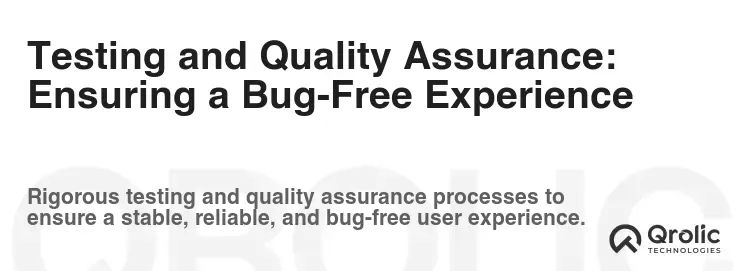
Testing and quality assurance (QA) are essential for ensuring that your eSports platform is bug-free, reliable, and user-friendly.
Types of Testing
- Unit Testing: Testing individual components of the platform to ensure they function correctly.
- Integration Testing: Testing the interaction between different components of the platform.
- System Testing: Testing the entire platform as a whole.
- User Acceptance Testing (UAT): Allowing users to test the platform and provide feedback.
- Performance Testing: Testing the platform’s performance under load.
- Security Testing: Testing the platform for security vulnerabilities.
Testing Tools
- Selenium: A popular tool for automating web browser testing.
- JMeter: A popular tool for performance testing.
- OWASP ZAP: A popular tool for security testing.
Bug Tracking System
- Jira: A popular bug tracking system.
- Bugzilla: Another popular bug tracking system.
Quality Assurance Best Practices
- Create a Test Plan: Develop a comprehensive test plan that outlines the scope of testing, the testing methodology, and the testing schedule.
- Write Test Cases: Write detailed test cases that cover all aspects of the platform.
- Automate Testing: Automate as much testing as possible to improve efficiency and reduce human error.
- Track Bugs: Track all bugs that are found during testing and ensure they are resolved promptly.
- Regression Testing: Perform regression testing after each bug fix to ensure that the fix did not introduce new bugs.
Marketing and Promotion: Getting the Word Out

Once your eSports platform is ready, you need to market and promote it to attract users.
Search Engine Optimization (SEO)
- Keyword Research: Research relevant keywords that your target audience is using to search for eSports platforms.
- On-Page Optimization: Optimize your website’s content, title tags, meta descriptions, and headings for relevant keywords.
- Off-Page Optimization: Build backlinks from other websites to improve your website’s authority.
- Content Marketing: Create valuable and engaging content that attracts and retains users.
Social Media Marketing
- Create Social Media Profiles: Create profiles on popular social media platforms, such as Facebook, Twitter, Instagram, and Twitch.
- Share Engaging Content: Share engaging content that is relevant to your target audience.
- Run Contests and Giveaways: Run contests and giveaways to attract new followers and increase engagement.
- Engage with Your Audience: Respond to comments and messages from your followers.
Influencer Marketing
- Identify Influencers: Identify influential players and streamers in your niche.
- Reach Out to Influencers: Reach out to influencers and offer them incentives to promote your platform.
- Collaborate with Influencers: Collaborate with influencers on content creation and marketing campaigns.
Paid Advertising
- Google Ads: Use Google Ads to target users who are searching for eSports platforms.
- Social Media Ads: Use social media ads to target users who are interested in eSports.
- Display Ads: Use display ads to target users who are visiting websites related to eSports.
Community Engagement
- Participate in eSports Events: Participate in eSports events and tournaments to promote your platform.
- Sponsor Teams and Players: Sponsor teams and players to increase brand awareness.
- Engage in Online Forums: Engage in online forums and discussions related to eSports.
Monetization Strategies: Generating Revenue

To sustain your eSports platform, you need to implement effective monetization strategies.
Subscription Model
- Premium Features: Offer premium features to paying subscribers, such as ad-free browsing, access to exclusive content, and priority matchmaking.
- Tiered Subscriptions: Offer tiered subscriptions with different levels of features and benefits.
Tournament Entry Fees
- Charge Entry Fees: Charge entry fees for tournaments to generate revenue.
- Prize Pool Contribution: Use a portion of the entry fees to contribute to the prize pool.
Advertising
- Display Ads: Display ads on the platform to generate revenue.
- Sponsored Content: Publish sponsored content from brands that are relevant to your target audience.
Sponsorships
- Team Sponsorships: Sponsor eSports teams to generate brand awareness.
- Tournament Sponsorships: Sponsor eSports tournaments to generate brand awareness.
Merchandise
- Sell Merchandise: Sell merchandise related to your platform, such as t-shirts, hoodies, and hats.
Legal Considerations: Staying Compliant
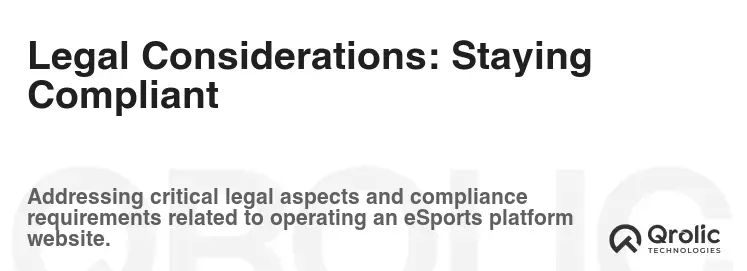
Navigating the legal landscape is crucial for the long-term success and stability of your eSports platform.
Terms of Service (ToS) and Privacy Policy
- Comprehensive ToS: Create a comprehensive Terms of Service that outlines the rules and regulations of the platform.
- Clear Privacy Policy: Create a clear Privacy Policy that explains how you collect, use, and protect user data.
Intellectual Property
- Copyright Protection: Protect your platform’s intellectual property, such as your logo, branding, and content.
- Game Licenses: Ensure that you have the necessary licenses to use copyrighted games and content on your platform.
Data Privacy Laws
- GDPR Compliance: If you are targeting users in the European Union, you need to comply with the General Data Protection Regulation (GDPR).
- CCPA Compliance: If you are targeting users in California, you need to comply with the California Consumer Privacy Act (CCPA).
Gambling Laws
- Avoid Illegal Gambling: Avoid offering any form of illegal gambling on your platform.
Qrolic Technologies and Your eSports Platform
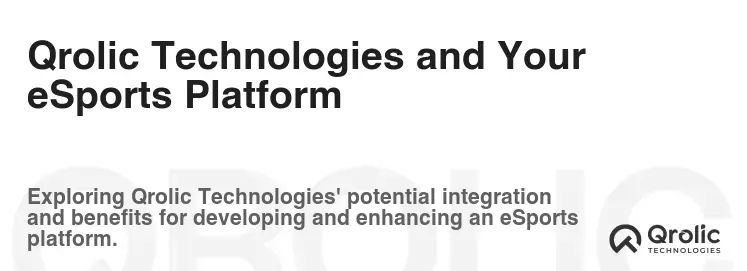
Qrolic Technologies (https://qrolic.com/) is a leading provider of web development and software solutions. They possess the expertise and experience to help you build a robust, scalable, and feature-rich eSports platform. From front-end design and back-end development to database management and cloud hosting, Qrolic Technologies can provide you with the comprehensive support you need to bring your vision to life. Their team of skilled developers can help you choose the right technology stack, design a user-friendly interface, and implement all the key features of a successful eSports platform. Whether you’re just starting out or looking to scale your existing platform, Qrolic Technologies can be a valuable partner in your journey.
Continuous Improvement: Adapting and Evolving
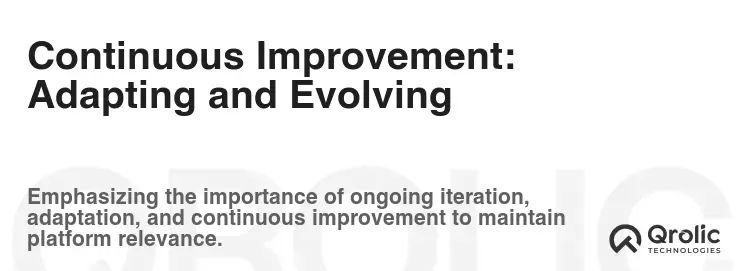
The eSports industry is constantly evolving, so it’s crucial to continuously improve your platform to stay ahead of the competition.
Collect User Feedback
- Surveys: Conduct regular surveys to gather feedback from users.
- Forums: Monitor community forums to identify areas for improvement.
- Analytics: Analyze user behavior data to identify areas where users are struggling.
Monitor Industry Trends
- Stay Up-to-Date: Stay up-to-date on the latest trends in the eSports industry.
- Analyze Competitors: Analyze your competitors to identify new features and strategies.
Implement New Features and Improvements
- Prioritize Improvements: Prioritize improvements based on user feedback and industry trends.
- Regular Updates: Release regular updates to the platform with new features and improvements.
Scalability and Performance
- Monitor Performance: Continuously monitor the platform’s performance to identify areas for optimization.
- Scale Infrastructure: Scale the platform’s infrastructure to handle increased traffic and user load.
By following this essential guide, you can create a successful eSports platform website that caters to the needs of players, organizers, and fans, fostering a thriving community and achieving your business goals. Remember to focus on user experience, choose the right technology, implement effective marketing strategies, and continuously improve your platform to stay ahead of the competition.







